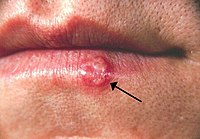
Photo from wikipedia
Objectives Muscle soreness occurs after exercise and also in musculoskeletal diseases, such as fibromyalgia (FM). However, the nosography and pathoetiology of morbid soreness in FM remain unknown. This study aimed… Click to show full abstract
Objectives Muscle soreness occurs after exercise and also in musculoskeletal diseases, such as fibromyalgia (FM). However, the nosography and pathoetiology of morbid soreness in FM remain unknown. This study aimed to investigate the morbid soreness of FM, evaluate its therapeutic responses and probe its pathophysiology with metabolomics profiling. Methods Patients with newly diagnosed FM were prospectively recruited and completed self-report questionnaires pertaining to musculoskeletal symptoms. The phenotypes and metabotypes were assessed with variance, classification and correlation analyses. Results Fifty-one patients and 41 healthy controls were included. Soreness symptoms were prevalent in FM individuals (92.2%). In terms of manifestations and metabolomic features, phenotypes diverged between patients with mixed pain and soreness symptoms (FM-PS) and those with pain dominant symptoms. Conventional treatment for FM did not ameliorate soreness severity despite its efficacy on pain. Moreover, despite the salient therapeutic efficacy on pain relief in FM-PS cases, conventional treatment did not improve their general disease severity. Metabolomics analyses suggested oxidative metabolism dysregulation in FM, and high malondialdehyde level indicated excessive oxidative stress in FM individuals as compared with controls (p=0.009). Contrary to exercise-induced soreness, lactate levels were significantly lower in FM individuals than controls, especially in FM-PS. Moreover, FM-PS cases exclusively featured increased malondialdehyde level (p=0.008) and a correlative trend between malondialdehyde expression and soreness intensity (r=0.337, p=0.086). Conclusions Morbid soreness symptoms were prevalent in FM, with the presentation and therapeutic responses different from FM pain conditions. Oxidative stress rather than lactate accumulation involved phenotype modulation of the morbid soreness in FM. Trial registration number NCT04832100.
Journal Title: RMD Open
Year Published: 2023
Link to full text (if available)
Share on Social Media: Sign Up to like & get
recommendations!